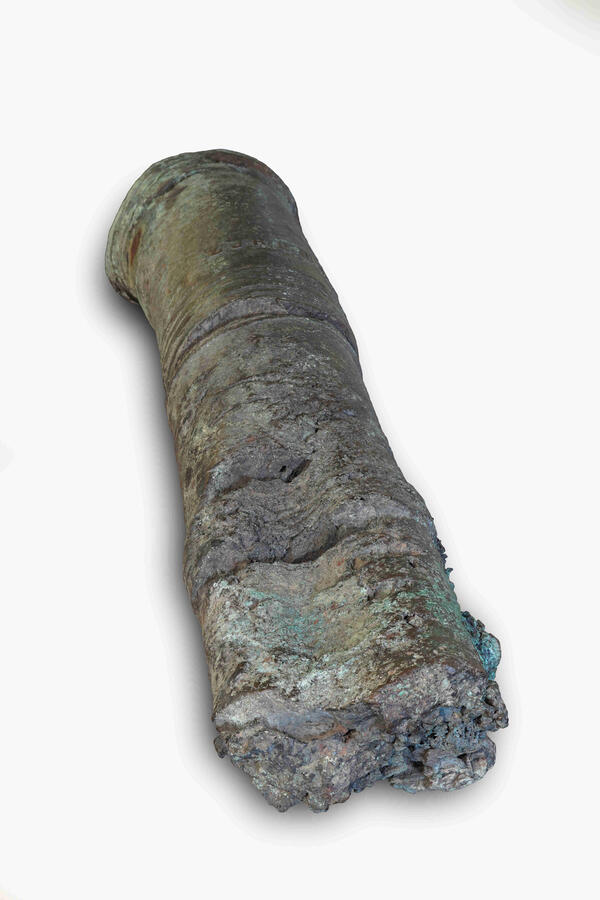Metal casting in Russia began to develop actively at the end of the 15th century, when Ivan III Vasilyevich invited talented specialists, including gunsmiths, to Moscow from abroad. Their efforts have created a “Cannon Izba” in Moscow. The weapons cast at this factory were made using the latest Western European technologies of that time. By the beginning of the 16th century, foreign gunsmiths were no longer a rarity in Moscow.
Kashpir Ganusov (Kaspar Hans) was a master of German or Lithuanian origin. He served for Ivan the Terrible in the 1550s and 1560s and, according to written sources, cast at least ten guns at the Moscow Cannon Court. They were successfully deployed in the Livonian War of 1558–1583, in campaigns near Kazan, Smolensk and Polotsk, were used by the troops of Arkhangelsk, Kholmogor, Kostroma, Kashira, Pereslavl-Zalessky and Moscow. Some of the master’s creations were used even in the second quarter of the 18th century.
Among Kashpir Ganusov’s students were skillful founders of the 16th–17th centuries Andrey Chokhov, Bogdan Andreytokhov, Nikita Tupitsyn, Yury Bochkarev, Kuzmin Pervoy and Semyon Dubinin.
Artillery pishchals (a Russian word derive from “pishchat” meaning “to peep”) were first mentioned in documents at the very end of the 14th century. This was the term for medium- and long-barreled guns that externally resemble a pipe (hence the name), which were used to fire at fortifications and enemy soldiers. They were divided into hand-held (also called “ruchnitsy” or “samopaly”) and fortress ones (“zatinnye”) for shooting from the fortress walls or from the carriage. In addition, siege, battering ram, field and regimental cannons (or “puschkas” in Russian — derived from the word “puschat” meaning “to throw”), loaded with iron or cast-iron balls, were called pishchals.
The presented exhibit is one of those pishchal guns. In the late 1570s, it was in service with the Kholm Fortress, not far from Pskov (Tatilovsky Hill, the left bank of the Lovat River). Although it was equipped with the best weapons for the 16th century, in 1781 the fortress was burned down by detachments of Hetman Jan Zamoyski and voivode Radziwill from the troops of Stephen Bathory.
In the summer of 1906, children playing on the Tatilovsky Hill accidentally discovered a cannon with the inscription “Kashpir”. In 1907, the find was transferred from the city of Kholm to the Historical Museum of Artillery.
To date, this is the only preserved weapon of Kashpir Ganusov.
Kashpir Ganusov (Kaspar Hans) was a master of German or Lithuanian origin. He served for Ivan the Terrible in the 1550s and 1560s and, according to written sources, cast at least ten guns at the Moscow Cannon Court. They were successfully deployed in the Livonian War of 1558–1583, in campaigns near Kazan, Smolensk and Polotsk, were used by the troops of Arkhangelsk, Kholmogor, Kostroma, Kashira, Pereslavl-Zalessky and Moscow. Some of the master’s creations were used even in the second quarter of the 18th century.
Among Kashpir Ganusov’s students were skillful founders of the 16th–17th centuries Andrey Chokhov, Bogdan Andreytokhov, Nikita Tupitsyn, Yury Bochkarev, Kuzmin Pervoy and Semyon Dubinin.
Artillery pishchals (a Russian word derive from “pishchat” meaning “to peep”) were first mentioned in documents at the very end of the 14th century. This was the term for medium- and long-barreled guns that externally resemble a pipe (hence the name), which were used to fire at fortifications and enemy soldiers. They were divided into hand-held (also called “ruchnitsy” or “samopaly”) and fortress ones (“zatinnye”) for shooting from the fortress walls or from the carriage. In addition, siege, battering ram, field and regimental cannons (or “puschkas” in Russian — derived from the word “puschat” meaning “to throw”), loaded with iron or cast-iron balls, were called pishchals.
The presented exhibit is one of those pishchal guns. In the late 1570s, it was in service with the Kholm Fortress, not far from Pskov (Tatilovsky Hill, the left bank of the Lovat River). Although it was equipped with the best weapons for the 16th century, in 1781 the fortress was burned down by detachments of Hetman Jan Zamoyski and voivode Radziwill from the troops of Stephen Bathory.
In the summer of 1906, children playing on the Tatilovsky Hill accidentally discovered a cannon with the inscription “Kashpir”. In 1907, the find was transferred from the city of Kholm to the Historical Museum of Artillery.
To date, this is the only preserved weapon of Kashpir Ganusov.





